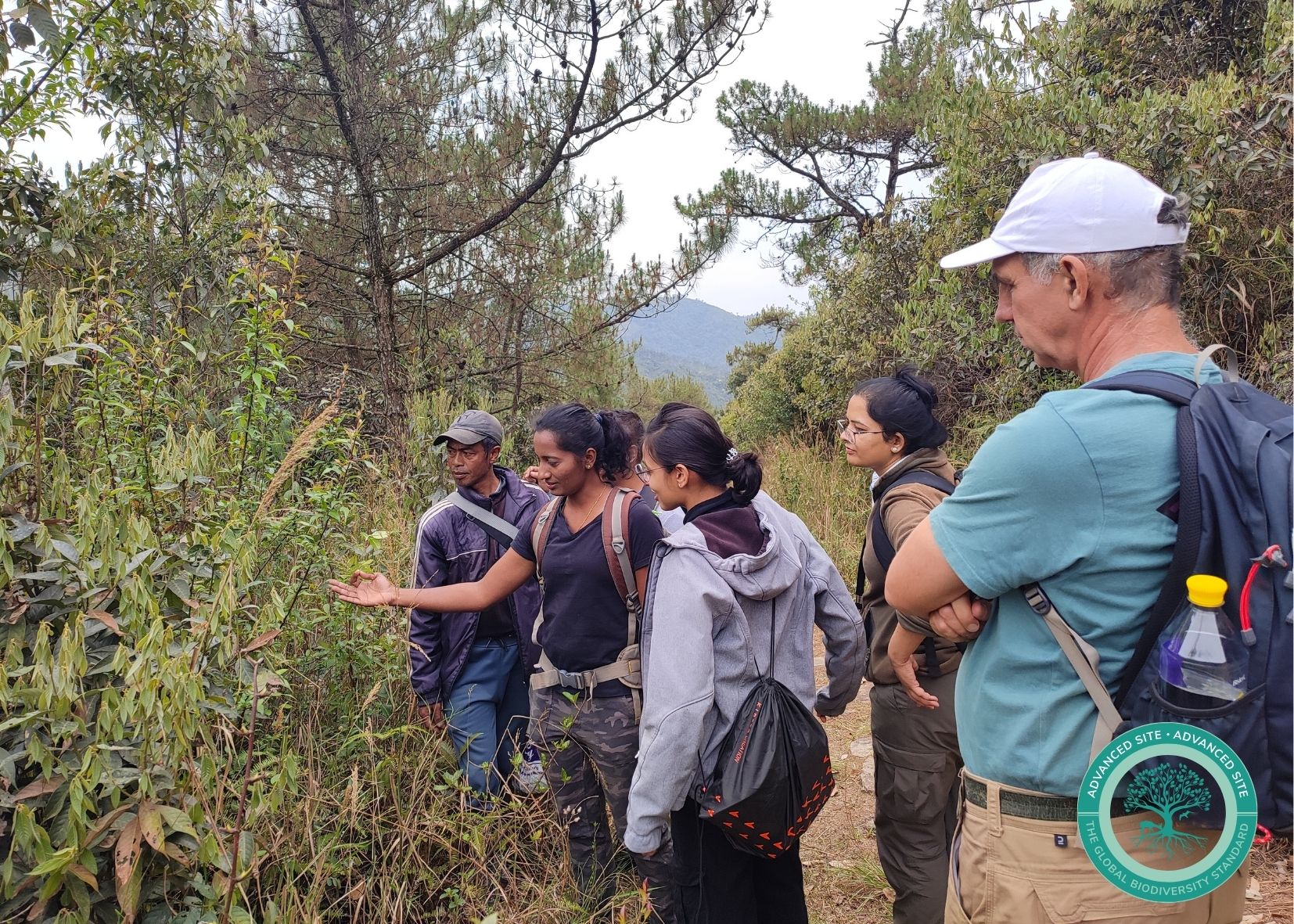India’s First TGBS-Certified Site Achieves Advanced Tier, A Landmark in Community-led Restoration
-
Country
India -
Region
Asia -
Programme
Global Biodiversity Standard -
Workstream
Saving Plants -
Topic
Conservation Prioritisation -
Type
News -
Source
BGCI
News published: 1 October 2025
The Lum Jong u Mong Community Protected Forest and the Sacred Grove of Laitkynsew in Meghalaya has become the first site in India, and across Asia, to be certified under The Global Biodiversity Standard (TGBS), achieving the Advanced Certification Tier. The site reflects remarkable performance in ecosystem recovery, community stewardship, and long-term conservation planning.
Located along a 45-hectare mountain ridge in the Khasi Hills, the site is managed by the Ka Synjuk Ki Hima Arliang Wah Umiam, Mawphlang Welfare Society (SYNJUK). The site is part of the larger Khasi Hills Community REDD+ Project, a pioneering community-based REDD+ initiative spanning 27,000 hectares and working with 86 community groups to protect sacred groves, watersheds, and restore degraded land. It is a Plan Vivo certified project, benefiting from carbon certificates for avoided deforestation and assisted natural regeneration.
The TGBS assessment evaluates improvement in biodiversity and ecosystem integrity from a defined baseline, in this case 2017, to the current year. Previously, the site faced major pressures from wildfires, firewood extraction, and over-grazing, leaving only scattered pockets of low-diversity native vegetation. Today, it is formally protected as a Law Adong – Sacred Grove and a Community Protected Forest.
Certification
The certification process was conducted in two phases. An initial pilot visit in 2024 tested compatibility of the project with TGBS. Rapid field and stakeholder surveys were conducted, offering early indications of recovery and community engagement. Following the project’s formal interest in certification, a comprehensive assessment took place in March 2025. This included detailed social surveys and community interviews, ecological fieldwork to evaluate flora and fauna, comparative analysis with intact reference ecosystems, surveys of degraded zones to establish baseline conditions, and a remote sensing analysis.
The site performed exceptionally across the eight biodiversity criteria of TGBS, achieving the maximum score for Criterion 2 – Level of Protection, 3 – Stakeholder Engagement, and 5 – Control of Invasive Species. The site also performed well across the remaining five criteria, covering ecosystem integrity, the use of native species, rare and threatened species, appropriate genetic diversity and robust monitoring, evaluation and adaptive management. These scores are expected to rise further as assisted natural regeneration continues and species diversity increases. Crucially, the reporting systems already in place under the REDD+ programme supported the TGBS assessment, particularly in meeting the standards for Criteria 3 and 8. This highlights a strong compatibility between carbon and biodiversity standards when well-designed and locally implemented.

Kiran Baldwin, Lead Assessor and coordinator of the TGBS-India Hub, commented:
“This site is an inspiring example of how ecological restoration can be strengthened with cultural and spiritual values. Natural recovery is well underway, aided by nearby intact forests, but there is potential to accelerate outcomes by introducing a greater diversity of native species based on the reference ecosystem. Expanding long-term monitoring of flora and fauna is key to tracking progress. The site’s ecological connectivity is also an opportunity for landscape-level restoration and corridor creation.”
With this Advanced Certification, the Lum Jong u Mong site now stands as a model for community-led, biodiversity-centred restoration in India and beyond, paving the way for future TGBS projects across Asia.
“The Lum Jong u Mong Community Protected Forest and the Sacred Grove, part of the Khasi Hills Community REDD+ project, is the first Plan Vivo Carbon project to receive the TGBS certification. This is a great achievement for the inspirational project, demonstrating the importance of integrating restoration efforts into REDD+ initiatives. The accreditation showcases how the project supports a vast range of biodiversity, and cultural heritage, in addition to the climate benefits. It also strengthens the credibility of nature-based carbon projects with robust biodiversity safeguards such as TGBS.”- Dr Toral Shah, Biodiversity Coordinator, Plan Vivo Foundation.
“The success at Lum Jong u Mong should inspire carbon project developers and funders to integrate robust biodiversity certification into their work. Poorly designed carbon projects can inadvertently harm biodiversity through inappropriate species selection, monocultures, or neglect of local ecosystems. Unlike many biodiversity components currently included in carbon standards, which often fail to rigorously measure outcomes, TGBS provides an outcome-based assessment that ensures projects truly protect, enhance, and restore biodiversity. We hope this modular addition will help create a market where verified biodiversity outcomes are valued and rewarded with better pricing. We congratulate the SYNJUK community and Plan Vivo Foundation for showing how this can be achieved in practice.” – Dr David Bartholomew, Manager, The Global Biodiversity Standard

Support BGCI
You can support our plant conservation efforts by sponsoring membership for small botanic gardens, contributing to the Global Botanic Garden Fund, and more!
Become a Member
Be part of the largest network of botanic gardens and plant conservation experts in the world by joining BGCI today!